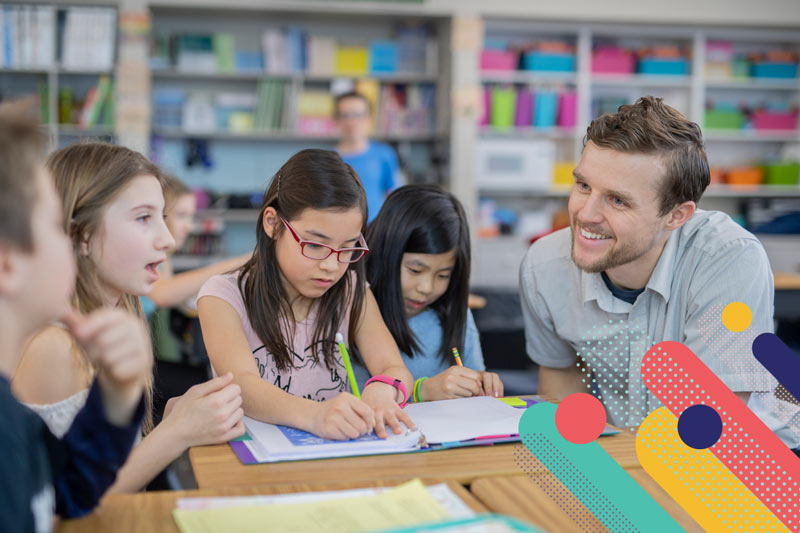Learning how to work in a group is an important skill our students need to be taught, practice, and learn. The process is messy and can be challenging. TeacherVision Advisory Board member Tara shares tips and resources for setting your students up for success while preserving your sanity.

As 21st century learners, your students need to be able to collaborate with their classmates and work together to solve problems. Integrating group work into your lessons is a great way to support your students to practice these skills. However, if there aren’t clear expectations and guidelines for group work, you can quickly lose control of your class. Here are some tips for making group work effective.
Practice Group Work in Fun Ways
When your students enter your classroom on the first day, you can’t expect them to be great at working in groups. It takes practice, and the more your students work in groups, the better they will get at it. One fun way to practice is having your students play games or review material on teams.
Model the Expectations for Group Work
I start teaching guided math groups and reading strategy groups the first few weeks of school. These small group settings are the perfect place to model the expectations for group work.
We discuss how to take turns talking, what to do if you disagree with someone, and how to work together to solve a problem. After I model it a few times, my students are able to do these things even when they’re working in groups without me sitting there.
Create an Anchor Chart for What Group Work Should Look Like
Having a visual reminder of the group work expectations is also important. I like to have my students help me create an anchor chart. I write “Group Work Expectations” at the top of the chart paper. Then, I label one side “Looks Like” and the other side “Sounds Like." My students help me brainstorm ideas for each column.
For example, group work looks like everyone sitting close together and each member of the group contributing. It sounds like quiet voices and students taking turns to talk.
I hang the anchor chart in the front of the room. Then, if a group isn’t following the directions, all I have to do is point to the chart to remind them of what’s expected.
Give Your Students Clear Directions When They Are Working in Groups
It’s very important for your students to know exactly what they’re supposed to do when they’re working in groups. Otherwise, they will be off task and chat about anything they want.
I like to post step-by-step directions on the board so my students know exactly what to do. This also saves me from repeating myself a hundred times.
Choose the Groups Yourself
At the beginning of the year I like to allow my students to choose their groups. However, depending on your class, this might not work. If your students can’t work with their friends and be productive, you might have to start choosing the groups.
I also seat my students in table groups, so I often have them work with the people that sit with them. This saves time, because they don’t have to move around before they get started on the activity.
Create Jobs for Different Members of the Group
If your students have a lot of tasks to do, you can assign each student a different role. I do this for our science groups, since the groups stay the same for the whole unit, and each experiment requires a lot of different jobs.
One student is the supply manager who is responsible for getting and returning all of the experiment materials. This way, only one student from each group is up and moving instead of the whole class. Another student is the reader, who reads the steps of the experiment to the group. The recorder takes notes for the group. The director makes sure everyone is on task and participating.
I rotate the jobs weekly so every student gets to do each job about once a month. Having these jobs for my science groups helps our experiments go a lot more smoothly.
Set Time Limits for When Things Should be Finished
Make sure your students know how long they have to accomplish their group work. If you don’t set a time limit, they won’t feel a sense of urgency, and they will get off task.
I like to project a timer on the board so my students can see exactly how much time they have left. If they choose not to use their time wisely, they have to find another time to complete it independently.
Have Something Planned for Groups That Finish Early
If groups finish before the timer goes off, you need to have something ready for them to do. I always check to make sure their work is done well before having them move on to something else.
If they completed the assignment well, I usually give them a related activity to work on while the rest of the class finishes. Sometimes they get to explore a website to learn more about the topic. I just make sure it’s not something I need the whole class to finish, since some groups won’t get to an extra activity.
Consider printing one of these choice boards so your early finishers is a task to keep them busy and learning.
Reward Groups That Are Working Well Together
This doesn’t have to be a physical reward. Simply pointing out that a certain group is working really hard goes a long way. It usually results in the other groups getting back on task so you will praise them, too.
If there are one or two students who are keeping a group from working well together, I pull those students and talk about how their behaviors are impeding their group. I give them one more chance to follow the expectations. If they still don’t, they have to complete the assignment independently. After that happens once, most students realize that it’s a lot easier to get the work done in the group, and their behavior is better the next time.
Our collection of printable rewards and certificates has everything you need for this. Or, create your own!
Have Students Reflect On How Their Group Work Went
After we work in groups, we always have a quick discussion about what went well and what we can improve for next time. I just have my students use a thumbs-up or thumbs-down to answer some questions first. For example, I ask them if everyone in their group helped equally. From a quick glance around the room, I can see which students felt like their group work went well.
Then, we talk about what should happen next time to make our group work go even better.
This graphic organizer for early elementary students and this organizer for upper elementary students are designed to support students to reflect on how their group work went.
Taking the time to set up your expectations for group work at the beginning of the year will save you a lot of headaches later. Once you set the guidelines and show your students that they have to follow them, group work in your classroom will be very productive. Your students will become expert collaborators and problem solvers.
How do you make group work more efficient in your classroom? Share with us on Instagram, Facebook, Twitter, and Pinterest.
Tara Dusko is a third grade teacher in Sinking Spring, Pennsylvania. She's spent the past 14 years finding engaging ways to make her students love learning. When she's not planning lessons for her classroom, she is spending time with her husband and two children or trying out new recipes in the kitchen. Get some tips for reducing the stress of teaching on her blog, Teach Without Tears.










